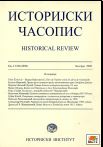Методи врбовања западноевропских најамника у Византији (1081-1185)
Recruitment Methods in Case of Westeuropean Mercenaries in Byzantium (1081-1185)
Author(s): Marko DraškovićSubject(s): History
Published by: Istorijski institut, Beograd
Keywords: medieval mercenaries; komninska army; recruiting mercenaries; XII century
Summary/Abstract: Based on data of contemporary byzantine and western sources, this work deals with reconstruction of basic recruitment principles of western mercenaries into Byzantine army during Comnenian epoch: direct recruitment via emissary, recruitment via local rulers, recruitment of passing-by crusades, recruitment of deserting enemy soldiers, recruitment of soldiers who came on their own iniative, and (hypothetically) recruitment of mercenaries via foreign traders and foreign cities. Direct recruitment of western mercenaries via emissary is attested several times during byzantine expeditions in Italy (1155-1157), during disturbances in Constantinople (1181, 1187), and in case of byzantine recruitment mission in Scandinavian Kingdoms (1195). Recruitment via local rulers is attested in case of recruitment via Baldwin III of Jerusalem Kingdom (1160), Konrad III of German Kingdom (1144/45), Robert I of Flanders (1089), with possibility that recruitments were made also via Henry II of England (during 1170s). Recruitment of passing-by crusades can be seen in case of crusaders from army of King Sigurd I of Norway (1122), Earl Ragnwald of Orkney (1151-53), armies of the First crusade (especialy after fall of Nicea) and of the Second crusade (esp. on route Nicea-Antioch). Recruitment of deserting enemy soldiers is esp. attested in many events concerning crash of Norman expeditions in Byzantium. Hypothetical recruitment via foreign traders and foreign cities can be assumed on ground of constant and vital economic and military bonds that Empire had during this epoch with italian maritime republics, Lombard cities and russian principalities. The work tries to show that western mercenaries predominantly were arriving in Byzantium as groups, but that were hired by Empire as individuals (examples from reigns of Alexius I and Mauel I). It also tries to imply routes by which latin mercenaries used on their way to Byzantium of the period - old russian way, route by german and hungarian lands (used by Sigurd I), route by westmediterranean coast (used by Ragnwald and Anglosaxons), route via Italy (used by many crusaders), routa via theAdriatic, etc. The work also includes some related questions like distribution of mercenaries in byzantine army, routes used by western mercenaries, inspection of mercenaries, etc.
Journal: Историјски часопис
- Issue Year: 2012
- Issue No: 61
- Page Range: 27-44
- Page Count: 18
- Language: Serbian

